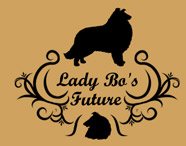Collie Colors
Bron: Colliefan.
Thank you Collie Fan, for your permission
⇒⇒Colliefan⇐⇐
Rough and Smooth Collies can come in a variety of colors from shades of sable, merle, tricolor and colored headed white to uncommon ones.
This is a list of colors and markings the Collie breed can come in (an asterisk means a uncommon color/marking). Some uncommon colors or markings mentioned here may not be a registered color or marking in conformation. Color standards vary from country to country.
Reference: "The New Collie" by The Collie Club of America, Texas Collie Rescue, NC Collie Rescue, various breeders.
Photo contribution credits: Romany Collies, NC Collie Rescue, Charlotte, Tairis Collies.
Reference: "The New Collie" by The Collie Club of America, Texas Collie Rescue, NC Collie Rescue, various breeders.
Photo contribution credits: Romany Collies, NC Collie Rescue, Charlotte, Tairis Collies.
Sable
Dominant over tricolor and bi-black. Shadings may be a straw color through a dark mahogany sable (shaded sable or saddle sable).
Shades of Sable...
|
|
Pure SableA clear shade of straw or orange with a light mask and no black markings. These individuals carry no tricolor gene and can produce only sable color regardless what color is combined with them.
|
|
|
Tri-factored SableSable Collies carrying the tricolor gene in conjunction with the dominant sable gene. Usually a honey-like color with semi-dark mask and a black spot on tail base, some have light black fringes.
|
|
|
Mahogany SableSable Collies carrying the tricolor gene in conjunction with the dominant sable gene. Usually a dark clear red to mahogany in color with dark masking and with some light black fringes on the back.
|
|
|
Tri - SableSable Collies carrying the tricolor gene in conjunction with the dominant sable gene. Shaded sable collies are tri-factored that are very dark with black masking and fringes to an almost black torso.
|
|
|
*Saddle BackSable Collies carrying the tricolor gene in conjunction with the dominant sable gene. Saddle sable collies are tri-factored that are very dark with black masking and a solid black torso.
|
Tricolor
|
|
Black TricolorRecessive to sable. Black Collies with white and tan points on sides of muzzle, above eyes, cheeks, chest and inner margins of legs.
|
|
|
*Red TricolorRed Collies with white and tan points on sides of muzzle, above eyes and inner margins of legs. Color results from a dilution of the black tricolor gene. The nose appears red and eyes may be hazel.
|
*Bi-black
|
|
Recessive to sable and tri-factored dogs. Bi-black Collies are solid black, white markings on the chest, feet and tip of tail. Some may or may not have a full white collar. Due to fads in the show ring and limiting other colors collies once came in, bi-black's are now rare. It's often seen in Shelties, English Shepherds and Border Collies.
|
Merle
A dominant dilution gene which in combination with sable or tri genes produces merled collies.
|
|
Blue MerleBluish to slate grey with black splotching, carrying sable markings in the same pattern as the tricolor. Color results from the interaction of the dominant dilution gene of merles with the tricolor gene.
|
|
|
Pure Sable MerlePure sable merles are usually a light or "washed out" sable at birth with brown merling. At maturity, quite often these Collies lose their merling and coat color becomes a clearer red. No tricolor gene is present in their makeup.
|
|
|
Dark Sable MerleThe tri-sable merle has a darker sable color than the pure sable merle with dark brown merling which quite frequently is still visible at maturity. The tricolor gene is present in conjunction with the sable and merle gene.
|
|
|
*HarlequinMostly white with either Sable or Tricolor with spotting. The tricolor gene is present in conjunction with the tricolor/sable and merle gene. Harlequin collies are uncommon and are considered a type of merle.
|
|
|
*Cryptic MerleA cryptic is a Merle that looks like a Tri color or Sable white none or little areas of Merling
|
|
|
*Red MerleSilver in color with red splotching, carrying sable markings in the same pattern as the tricolor. Color results from the interaction of the dilution gene of merles with the tricolor gene.
*Bi-Blue MerleBi-blue merle Collies are a blue merle without tan. Due to fads in the show ring and limiting the other natural colors collies once came in, they're now very rare.
|
*Piebald
|
|
Piebald or piebald-factored, isn't a color but a coat condition. It's also called a mismark. Piebald is a white-factored dog with excessive white in blotches creating a unique, pinto pattern. Piebald can occur in sable, tricolor or blue merle. It's a separate gene than a white merle (double dilute) and does not cause hearing/sight impairments.
|
White (CHW or Color-Headed White)
These are the result of a cross between either two white parents or white factored parents. Color is carried on a recessive white gene and is inherited independently of sable, tri or blue merle and may occur in combination with any of them. Not to be confused with Double Dilutes.
Coat Conditions
These aren't actual colors, but various conditions of coats such as white factored, non-white factored, piebald and double dilute. A recessive dilute gene causes tricolor coats appear blue and blue merle coats a maltese blue. A dilute should not be confused with the double dilute.
Double Dilute (white merle)Resulting from the combination of two merled parents. These Collies inherit the dominant dilution gene of merles from both parents. They are almost all white in appearance and may or may not have a few merling spots. If eyes are present, they are pale blue; skin including the eyelids, lips and nose are pink. Hearing and sight are usually impaired. White merles cannot be registered or shown.
|




































































